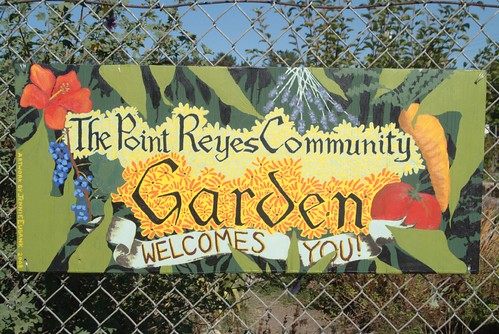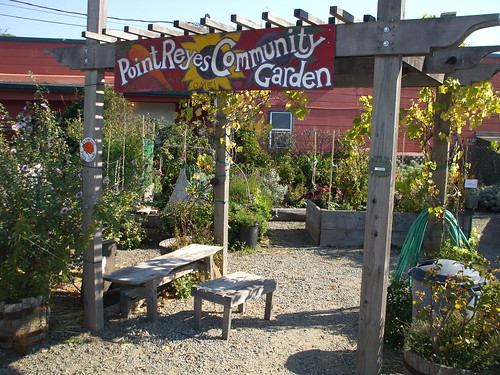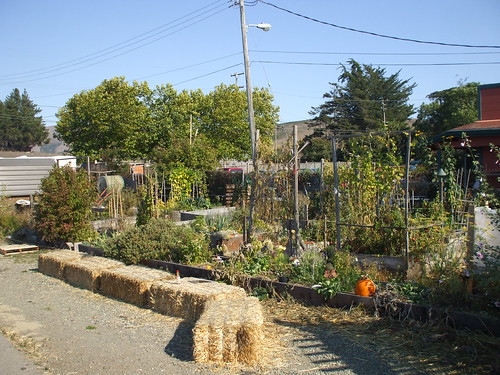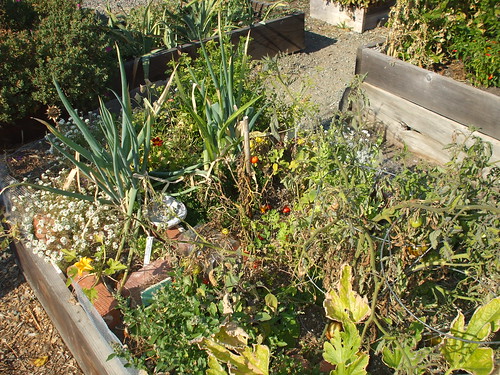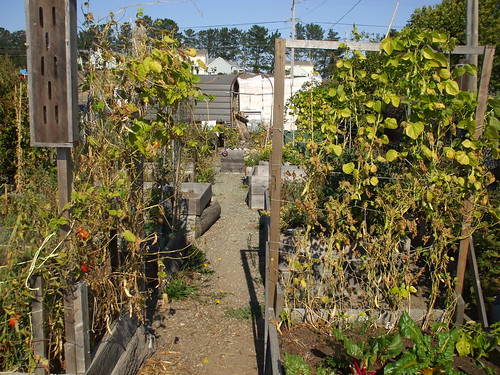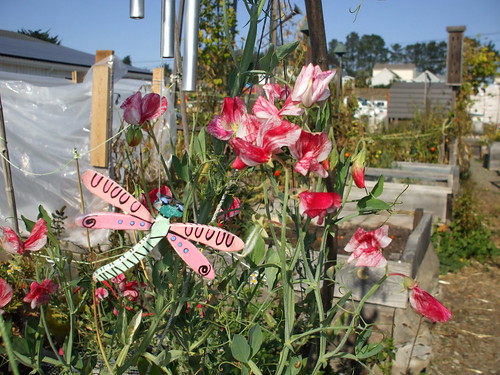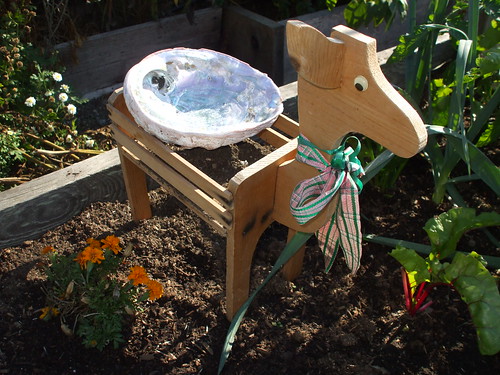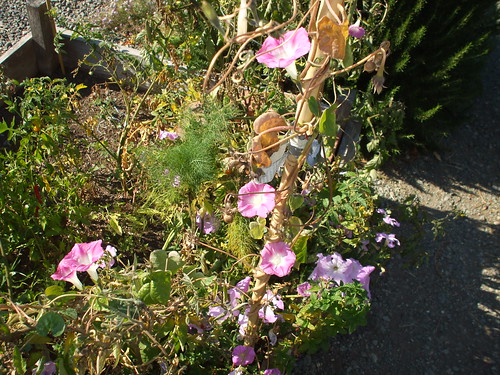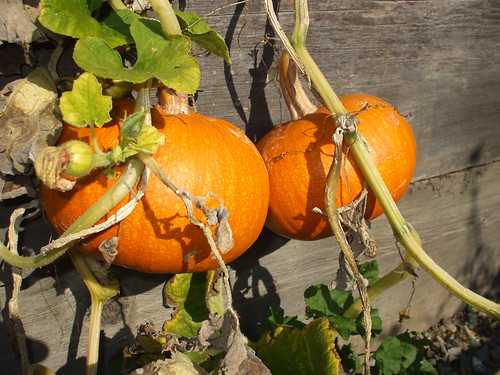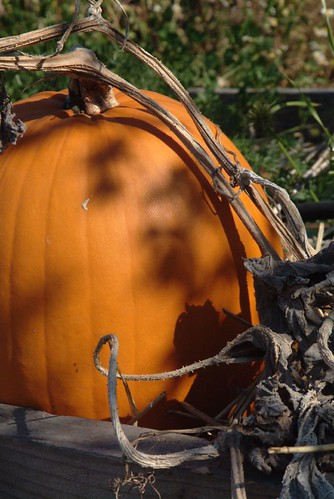Are you dressing up? We're going out of town for the weekend, so I got in the spirit a little early.
10/30/08
Rain
The first big fall rainstorm is always news here.
"Blustery winds and pounding surf Thursday announced the arrival of a series of low pressure troughs off the Northern California coast, bringing with them the threat of showers and the possibility of the first significant snows to the Sierra Nevada ski resorts." Link.
It's fine to snow somewhere else, but the rain is a threat. It's not the promise of rain. It's not the gift of rain. No, the rain is going to assault us. It's harrassment. Someone should sue the rain.
That's California for you.
"Blustery winds and pounding surf Thursday announced the arrival of a series of low pressure troughs off the Northern California coast, bringing with them the threat of showers and the possibility of the first significant snows to the Sierra Nevada ski resorts." Link.
It's fine to snow somewhere else, but the rain is a threat. It's not the promise of rain. It's not the gift of rain. No, the rain is going to assault us. It's harrassment. Someone should sue the rain.
That's California for you.
10/29/08
P-house, the first disc
I ended up buying the Penelope Hobhouse DVD, The Art and Practice of Gardening. I blogged my notes about the second disc in the 2-disc set here and here. Now I have the first disc and I've probably watched it two, maybe three, dozen times in the last two months.
I'm not even remotely tired of it. As soon as the disc is done, I reach for the remote and press the 'play' button. Thank goodness I have other things going on in my life that demand my attention. Otherwise I don't know how or when I would ever peel myself away. It's driving Guy nuts.
She starts the first disc talking about roses. She wants you to know that you can grow roses in different ways--as shrubs, climbers, and hedges. "You don't have to grow them massed in beds all by themselves." I think we're all on board with that.
She takes us to Graham Stuart Thomas' garden of of old roses at Mottisfont Abbey in Hampshire. Old roses are uniformly pale whites, pinks, mauves--all with a touch of blue. Harsh notes of orange or yellow in a rose are strictly modern.
Climb roses up old apple trees. Keep them nearby for fragrance.
Old roses typically bloom once per season in the spring (but the season of bloom can be long). P-house's docent, writer and historian Patrick Taylor, tries to spin the non-repeating season by invoking the pleasures of seasonal variation. He tries to explain that having constant blooming could get tedious, but P-house cuts him off sharply. (I love it when she does that.)
Rosa complicata, Rosa mundi, 'Alba maxima', 'Constance Spry' (an Austin rose), some others, get discussed. Rosa mundi is one of the oldest garden roses. Passion and dedication saved the old roses which would otherwise be lost to us now.
By the end of the 19th century, people were tired of the "old" roses and wanted long-blooming roses of uniform height and proportion. Interest in the old roses was revived after WWII. During that time, the modern shrub rose was introduced; its key features are repeat blooming, graceful form, and fragrance.
We meet David Austin in central England. He wanted to cross old roses to get the fragrance and shape of old roses, but with repeat-flowering. He says no flower varies as much as a rose, no flower is more difficult to photograph, or paint. Hmm.
'Constance Spry' and 'Chianti' were Austin's first crosses, but they did not repeat-flower. So he back-crossed with repeat-flowering types until finally he produced 'Wife of Bath'. It was 'Graham Thomas' and 'Mary Rose' however which signified the breakthroughs that made him famous.
In the next garden we get a lesson on the unique feel and attitude of ramblers. Where climbing roses are formal and architectural, English gardeners in the 1920s enjoyed using wild, romantic ramblers to "destroy" their otherwise formal, geometric garden patterns.
Think nothing of pruning wayward rambler stems that obscure the flowers. Ramblers are pruned immediately after flowering. Pliable rambler stems can be used to achieve diverse effects. Any free-standing shrub rose that grows to 5-feet will grow to 8 or 10 feet while trained against a wall. Ramblers make strong companions for other plants, especially evergreens. Examples are shown that combine different textures and feels.
P-house shows us some of the roses she grows. She praises 'Irene Watts' most of all. She concludes by reinforcing the idea that roses have diverse habits that you can use in different ways to make your garden "as beautiful as possible". There's that tyranny of the beautiful again. I'm against that, but I get it.
That's the end of the unit on roses.
The next unit is landscape gardening. The 18th-century English landscape garden, she says, is the greatest art form England has ever produced, having been copied all over the world. These gardens banished intimate flower gardens from near the house in favor of oneness with nature. Sheep and cattle grazed on the grass while trees grew into natural shapes. By the Victorian era, people were tired of this and revived the old intimacy. Ye Olde Intamacie. William Robinson is much discussed and soon we're off to Henry DuPont's garden at Winterthur.
While I love the subject matter, I have a hard time bonding with this unit. I think it's the plants. For a natural garden, may I recommend my Aug-06 visit to the Bloedel Reserve in Washington state, or better, go visit Outside Clyde.
I do like the discussion about growing plants in layers to let them show in succession. I appreciate the admonition to always ask where a plant comes from so that you can benefit from that knowledge when building your garden. P-house gets philosophical when she says that natural gardens move all parts of one's soul, whereas a formal garden appeals to logic and intellect which affects us too, but in a different way.
The discussion of Gertrude Jeckyll could be more. P-house sums up her philosophy on natural gardening by saying she's editing nature, not dictating to nature. Okay, we're good with the natural garden.
Next: Structural Elements. We're talking about the bones now.
P-house includes the color of paint you use in your garden as a structural element. She uses black. Her garden gates and garden furniture are all painted black. The walls are red brick. The paths are a gray, clayey gravel local to Dorset.
She hides her car under a pergola hidden by a hornbeam hedge. You should always think about your car when you lay out your garden because cars reflect light and spoil a view.
Rosemary Verrey's garden is next. What a charming, lovely lady she is. Her house dates to 1697. She calls it a humble country manor garden. Well, it has a Grecian temple. Gardening began in 1954. Your garden should always curtsy to your house according to Rosemary Verey citing Gertrude Jeckyll. In summer, a garden should be full of careless rapture. Terribly important to have verticals as well as horizontals. It's very important to copy ideas from other people. Verey copied a French garden's linden trees under-planted at the base with ivy and pruned into little balls...
Oops...okay, time for an abrupt halt. One of those other things going on in my life is calling me away from the Art of Gardening. Turns out it's bedtime now.
More P-house later.
I'm not even remotely tired of it. As soon as the disc is done, I reach for the remote and press the 'play' button. Thank goodness I have other things going on in my life that demand my attention. Otherwise I don't know how or when I would ever peel myself away. It's driving Guy nuts.
She starts the first disc talking about roses. She wants you to know that you can grow roses in different ways--as shrubs, climbers, and hedges. "You don't have to grow them massed in beds all by themselves." I think we're all on board with that.
She takes us to Graham Stuart Thomas' garden of of old roses at Mottisfont Abbey in Hampshire. Old roses are uniformly pale whites, pinks, mauves--all with a touch of blue. Harsh notes of orange or yellow in a rose are strictly modern.
Climb roses up old apple trees. Keep them nearby for fragrance.
Old roses typically bloom once per season in the spring (but the season of bloom can be long). P-house's docent, writer and historian Patrick Taylor, tries to spin the non-repeating season by invoking the pleasures of seasonal variation. He tries to explain that having constant blooming could get tedious, but P-house cuts him off sharply. (I love it when she does that.)
Rosa complicata, Rosa mundi, 'Alba maxima', 'Constance Spry' (an Austin rose), some others, get discussed. Rosa mundi is one of the oldest garden roses. Passion and dedication saved the old roses which would otherwise be lost to us now.
By the end of the 19th century, people were tired of the "old" roses and wanted long-blooming roses of uniform height and proportion. Interest in the old roses was revived after WWII. During that time, the modern shrub rose was introduced; its key features are repeat blooming, graceful form, and fragrance.
We meet David Austin in central England. He wanted to cross old roses to get the fragrance and shape of old roses, but with repeat-flowering. He says no flower varies as much as a rose, no flower is more difficult to photograph, or paint. Hmm.
'Constance Spry' and 'Chianti' were Austin's first crosses, but they did not repeat-flower. So he back-crossed with repeat-flowering types until finally he produced 'Wife of Bath'. It was 'Graham Thomas' and 'Mary Rose' however which signified the breakthroughs that made him famous.
In the next garden we get a lesson on the unique feel and attitude of ramblers. Where climbing roses are formal and architectural, English gardeners in the 1920s enjoyed using wild, romantic ramblers to "destroy" their otherwise formal, geometric garden patterns.
Think nothing of pruning wayward rambler stems that obscure the flowers. Ramblers are pruned immediately after flowering. Pliable rambler stems can be used to achieve diverse effects. Any free-standing shrub rose that grows to 5-feet will grow to 8 or 10 feet while trained against a wall. Ramblers make strong companions for other plants, especially evergreens. Examples are shown that combine different textures and feels.
P-house shows us some of the roses she grows. She praises 'Irene Watts' most of all. She concludes by reinforcing the idea that roses have diverse habits that you can use in different ways to make your garden "as beautiful as possible". There's that tyranny of the beautiful again. I'm against that, but I get it.
That's the end of the unit on roses.
The next unit is landscape gardening. The 18th-century English landscape garden, she says, is the greatest art form England has ever produced, having been copied all over the world. These gardens banished intimate flower gardens from near the house in favor of oneness with nature. Sheep and cattle grazed on the grass while trees grew into natural shapes. By the Victorian era, people were tired of this and revived the old intimacy. Ye Olde Intamacie. William Robinson is much discussed and soon we're off to Henry DuPont's garden at Winterthur.
While I love the subject matter, I have a hard time bonding with this unit. I think it's the plants. For a natural garden, may I recommend my Aug-06 visit to the Bloedel Reserve in Washington state, or better, go visit Outside Clyde.
I do like the discussion about growing plants in layers to let them show in succession. I appreciate the admonition to always ask where a plant comes from so that you can benefit from that knowledge when building your garden. P-house gets philosophical when she says that natural gardens move all parts of one's soul, whereas a formal garden appeals to logic and intellect which affects us too, but in a different way.
The discussion of Gertrude Jeckyll could be more. P-house sums up her philosophy on natural gardening by saying she's editing nature, not dictating to nature. Okay, we're good with the natural garden.
Next: Structural Elements. We're talking about the bones now.
P-house includes the color of paint you use in your garden as a structural element. She uses black. Her garden gates and garden furniture are all painted black. The walls are red brick. The paths are a gray, clayey gravel local to Dorset.
She hides her car under a pergola hidden by a hornbeam hedge. You should always think about your car when you lay out your garden because cars reflect light and spoil a view.
Rosemary Verrey's garden is next. What a charming, lovely lady she is. Her house dates to 1697. She calls it a humble country manor garden. Well, it has a Grecian temple. Gardening began in 1954. Your garden should always curtsy to your house according to Rosemary Verey citing Gertrude Jeckyll. In summer, a garden should be full of careless rapture. Terribly important to have verticals as well as horizontals. It's very important to copy ideas from other people. Verey copied a French garden's linden trees under-planted at the base with ivy and pruned into little balls...
Oops...okay, time for an abrupt halt. One of those other things going on in my life is calling me away from the Art of Gardening. Turns out it's bedtime now.
More P-house later.
10/25/08
Misc.
Les passed by a cotton field and has some thoughts you may wish to know. Link.
San Francisco gets an Andy Goldsworthy sculpture. Link. (Stanford has the Bay Area's only other Goldsworthy that I know about. Link. Well, no, there's his project at the DeYoung, too.)
Behold the dramatic range of human facial expression: baby gets a bath. (And tell me what that thing is in the lower right-hand corner of the first picture.)
Annie's Annuals 20%-off mail order sale ends on Friday. Things I want: Campanula vidalii, Cussonia transvaalensis, Puya mirabilis.
Would you grow a purple tomato? I would.
Slime molds. Insects.
San Francisco gets an Andy Goldsworthy sculpture. Link. (Stanford has the Bay Area's only other Goldsworthy that I know about. Link. Well, no, there's his project at the DeYoung, too.)
Behold the dramatic range of human facial expression: baby gets a bath. (And tell me what that thing is in the lower right-hand corner of the first picture.)
Annie's Annuals 20%-off mail order sale ends on Friday. Things I want: Campanula vidalii, Cussonia transvaalensis, Puya mirabilis.
Would you grow a purple tomato? I would.
Slime molds. Insects.
Saturday morning garden
It's not even noon yet. It's gonna get hot today. [ADDED: Later in the afternoon, the 100 deg F float settled to the bottom.]
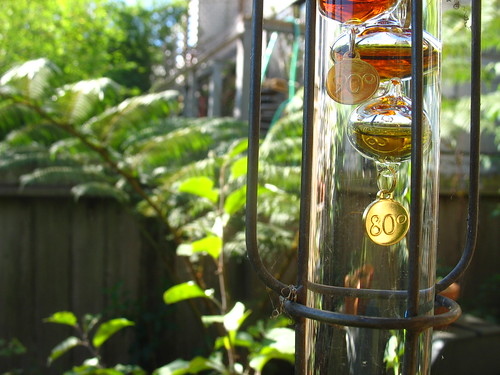
I haven't been able to see these crocus flowers until now.
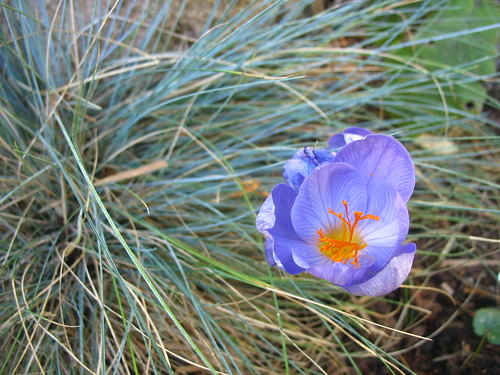
I leave for work before they open, and they're closed by the time I get home.
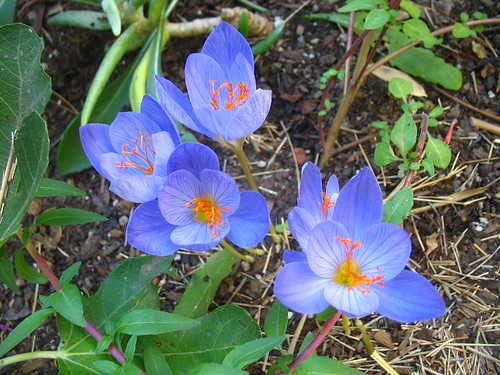
Crocus speciosus.
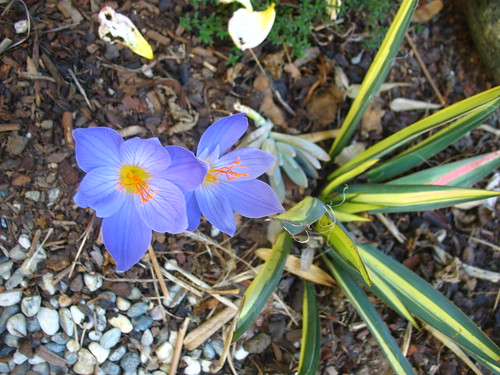
They're all over the place.
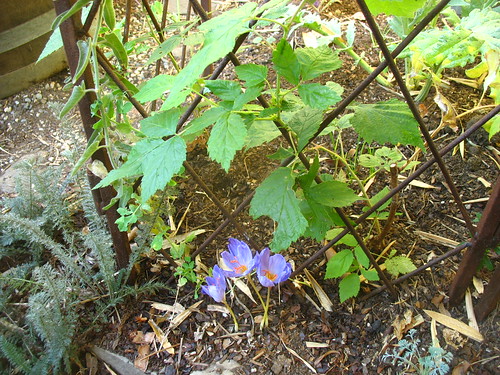
I even have a few white ones. I don't remember buying these at all.
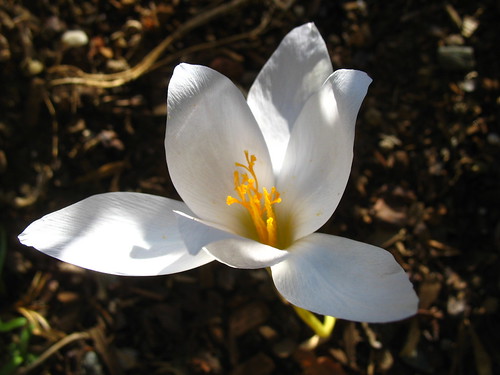
Looking up and around, the garden is pretty quiet right now.
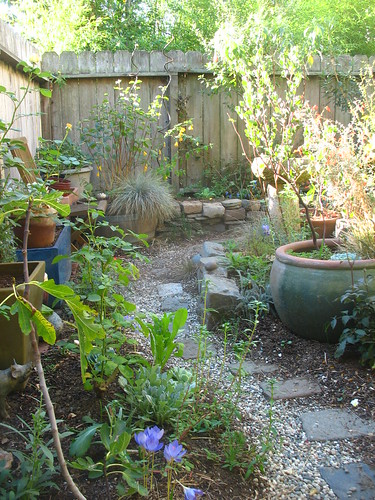
The Meyer lemon recently shot out a half-dozen new branches.
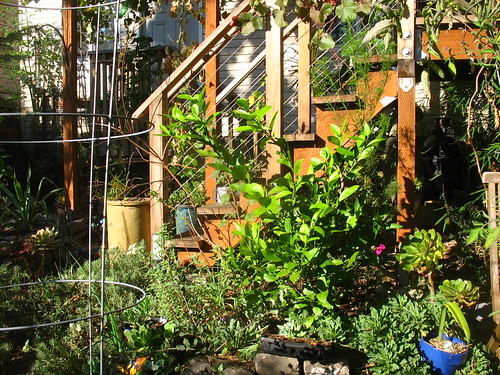
This plant grows in bursts. People say you can grow it well in containers, and I know some of you do, but I have not found that to be the case for me. I tried several times in a container--varying the potting mix, the fertilizer regime, the exposure--always to poor results. Last year I decided to plant one in the ground and it's doing very well. People say the Eureka lemon is a better choice for San Francisco, but, well, whatever.
Indian summer will ripen the last of the tomatoes.

You never really know when the season will end.
I pulled some carrots today to make room for Ocimum 'African Blue'. These 'Thumbelina' are good if you can't be bothered to prepare the soil.
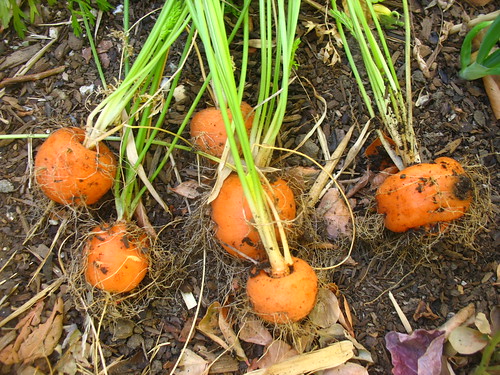
The Scarlet Runner Beans (Phaseolus coccinneus) are totally done, as you can see by the crispy brown leaves. Last year I ripped them out, but this year I'm going to let them overwinter. Hopefully, I'll get a jump on the season next spring.
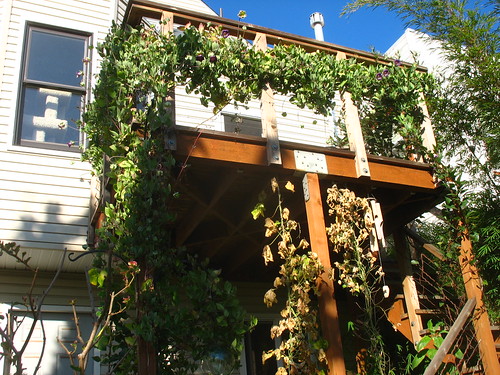
Cobaea scandens is still going strong...
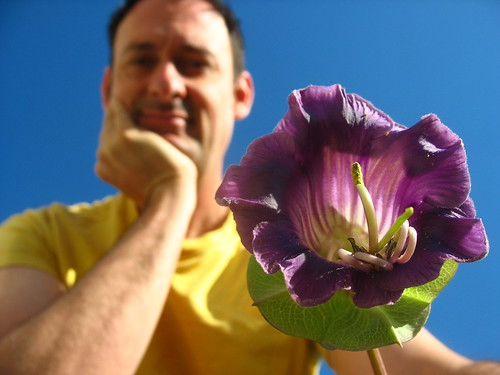
And Hardenbergia violacea has begun to flower.
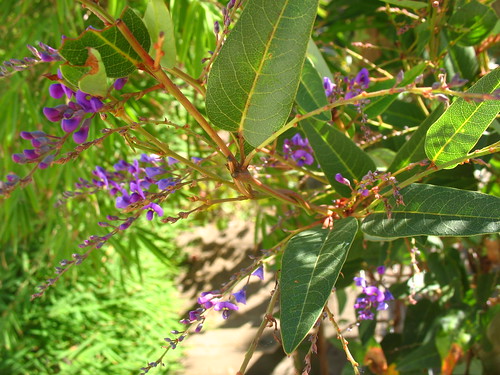
This plant keeps my Bloom Day posts aloft all winter. It's nice to see it again!
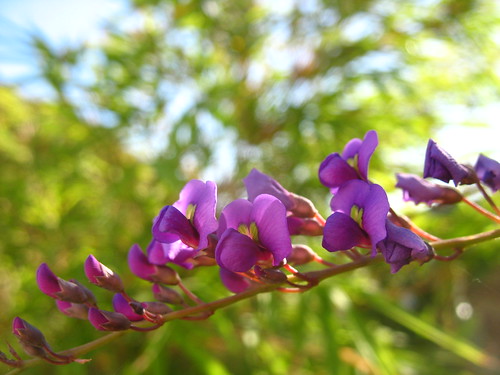
You might not be able to tell from this picture, but Epilobium canum is winding down.
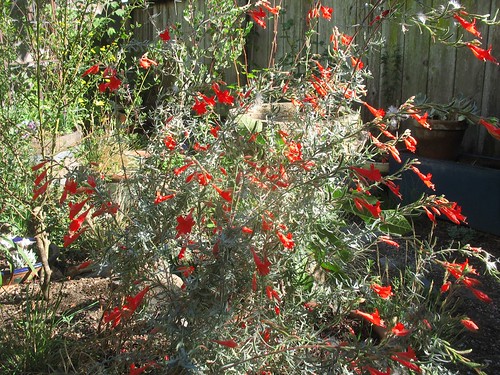
Here tho' you can see it's making seed.
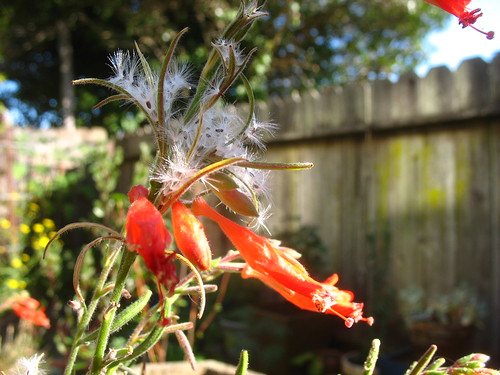
What else...
Under the deck, some of the cyclamen have come back vigorously. Others have just started to send up a leaf or two. They're not any kind of special cyclamen. Just what I found at the nursery in the discount pile.
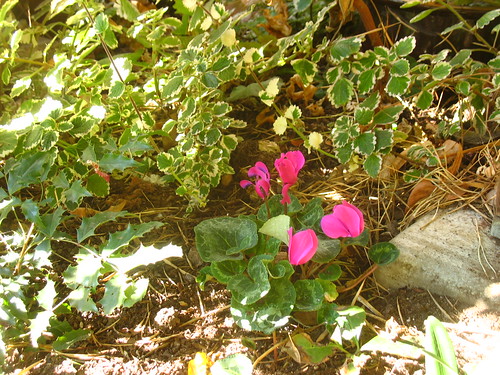
Some dahlia I started from seed in May or June are all moldy. Next year I'll plant out whatever comes back.
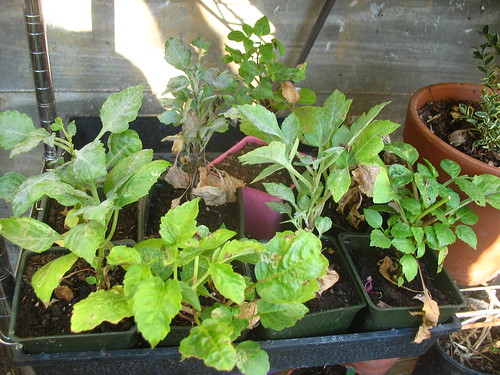
The spring wildflower starts are doing fine. Lots of seedlings coming up on their own in the garden too which is nice to see. Who knows, some of these might even flower before spring.
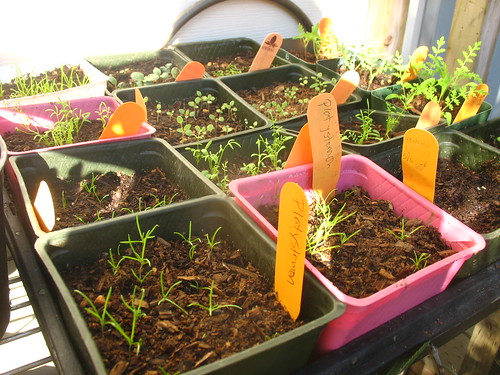
(Note: Stylomecon heterophylla was the last to germinate--at least a couple of weeks later than everyone else.)
I don't have the fall color display you may have right now... I have two Acer palmatum, still quite green. I thought the grape was going to turn early this year, but it's still about 80% green. I have four tiny vine maples (Acer circinatum), and only one of them has a feeling of fall.
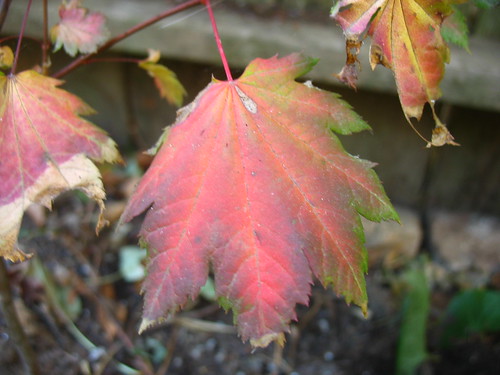
Tiny little thing.
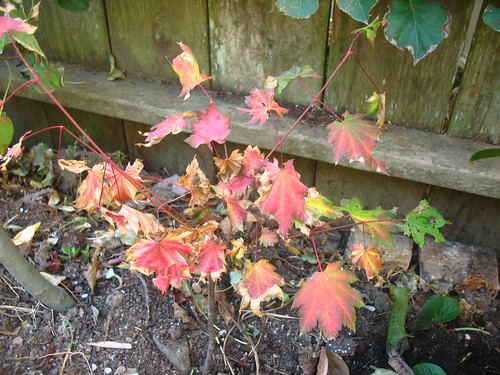
I'm going to plant the rest of my fall bulbs today. I have quite a few in the ground already, but they keep coming in the mail.
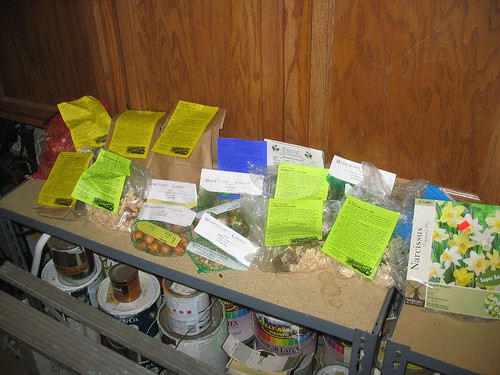
It's rather comical, isn't it? Of course, you order these things several months before they come. You pretty much forget what you asked for. You certainly did not expect their arrival to coincide with a global financial meltdown making you feel like a profiligate spender in times of parsimony.
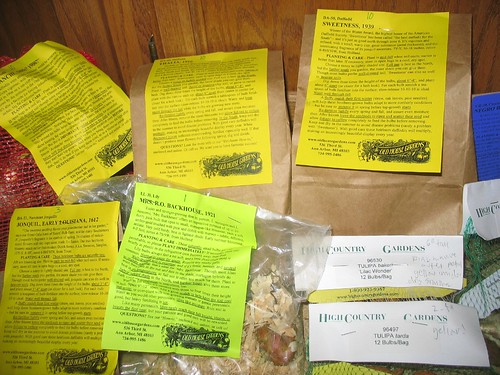
Instead, try not to think about it.
Things will get better by next spring.

I haven't been able to see these crocus flowers until now.

I leave for work before they open, and they're closed by the time I get home.

Crocus speciosus.

They're all over the place.

I even have a few white ones. I don't remember buying these at all.

Looking up and around, the garden is pretty quiet right now.

The Meyer lemon recently shot out a half-dozen new branches.

This plant grows in bursts. People say you can grow it well in containers, and I know some of you do, but I have not found that to be the case for me. I tried several times in a container--varying the potting mix, the fertilizer regime, the exposure--always to poor results. Last year I decided to plant one in the ground and it's doing very well. People say the Eureka lemon is a better choice for San Francisco, but, well, whatever.
Indian summer will ripen the last of the tomatoes.

You never really know when the season will end.
I pulled some carrots today to make room for Ocimum 'African Blue'. These 'Thumbelina' are good if you can't be bothered to prepare the soil.

The Scarlet Runner Beans (Phaseolus coccinneus) are totally done, as you can see by the crispy brown leaves. Last year I ripped them out, but this year I'm going to let them overwinter. Hopefully, I'll get a jump on the season next spring.

Cobaea scandens is still going strong...

And Hardenbergia violacea has begun to flower.

This plant keeps my Bloom Day posts aloft all winter. It's nice to see it again!

You might not be able to tell from this picture, but Epilobium canum is winding down.

Here tho' you can see it's making seed.

What else...
Under the deck, some of the cyclamen have come back vigorously. Others have just started to send up a leaf or two. They're not any kind of special cyclamen. Just what I found at the nursery in the discount pile.

Some dahlia I started from seed in May or June are all moldy. Next year I'll plant out whatever comes back.

The spring wildflower starts are doing fine. Lots of seedlings coming up on their own in the garden too which is nice to see. Who knows, some of these might even flower before spring.

(Note: Stylomecon heterophylla was the last to germinate--at least a couple of weeks later than everyone else.)
I don't have the fall color display you may have right now... I have two Acer palmatum, still quite green. I thought the grape was going to turn early this year, but it's still about 80% green. I have four tiny vine maples (Acer circinatum), and only one of them has a feeling of fall.

Tiny little thing.

I'm going to plant the rest of my fall bulbs today. I have quite a few in the ground already, but they keep coming in the mail.

It's rather comical, isn't it? Of course, you order these things several months before they come. You pretty much forget what you asked for. You certainly did not expect their arrival to coincide with a global financial meltdown making you feel like a profiligate spender in times of parsimony.

Instead, try not to think about it.
Things will get better by next spring.
10/23/08
The cheese shop
I like the little cheese shop at the corner of 12th and Irving. I think it's a mom & pop business and they have another store in Glen Park.
I come here for lunch and get a sandwich once or twice a week. It's close enough to my office to walk to, and far enough to give me a little exercise and clear my mind.
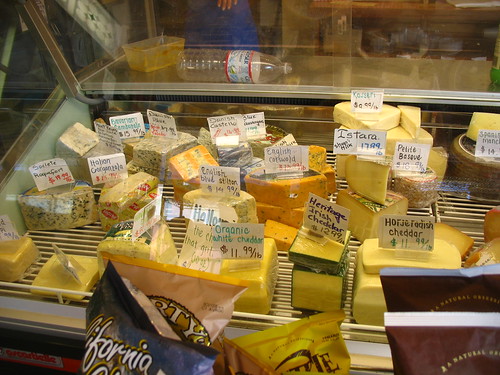
They sell mostly imported European cheeses, but there are some Californian goat cheeses too.
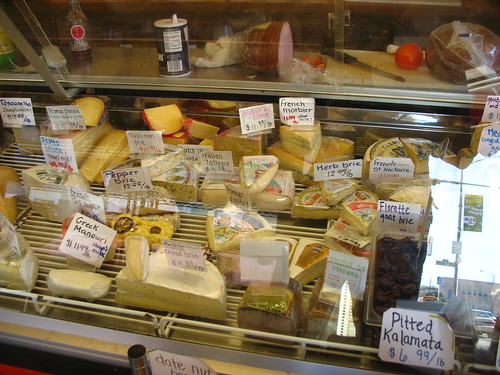
I like cheese, but I'm not a connoisseur. English Cotswold is my favorite.
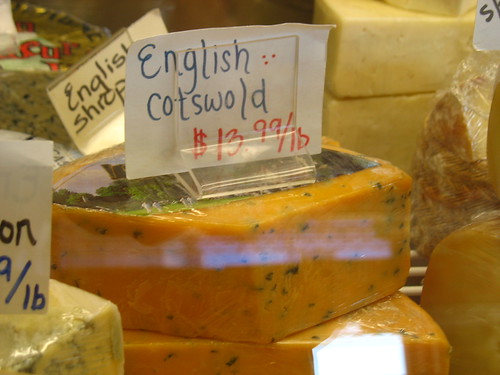
They sell other things. All the olives are imported.
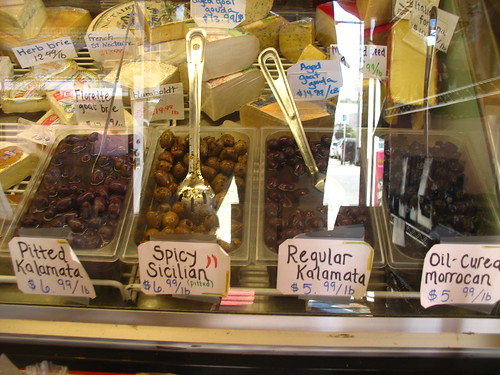
And they make sandwiches. I usually geta ham and cheese.
On days when the husband's there, I say "Can I have a ham and cheese sandwich?" and he makes it for me. When the wife is there, I say "Can I have a ham and cheese sandwich?" and she comes back with, "What kind of ham? What kind of cheese? What kind of bread? Do you want everything? Onions?"
Most peoople (most Americans?) probably prefer the wife's approach, and that's fine. I get that. But I actually prefer the husband's approach. If I wanted to micromanage every detail of my sandwich, I would say so when I placed my order. It's just a sandwich.
There--that's a little something about me you might not have known.
I don't usually get a drink, but these look good.
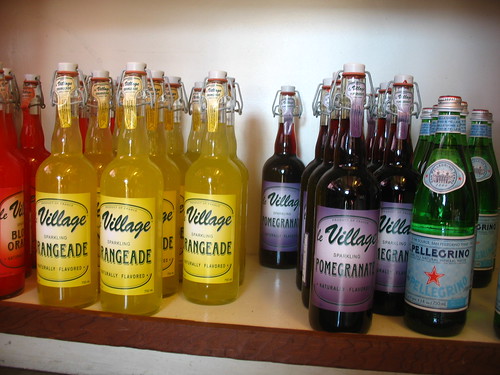
And so do these.
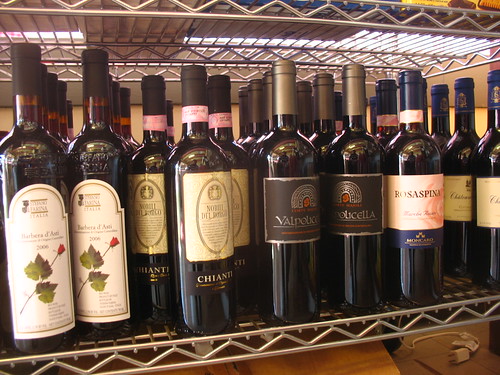
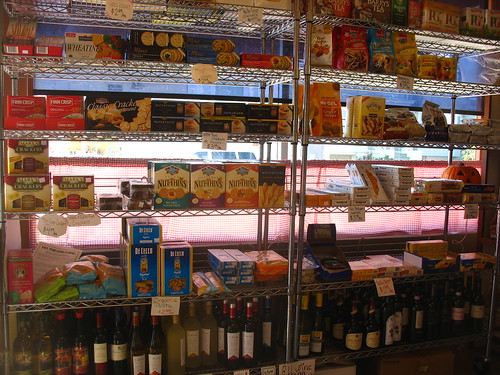
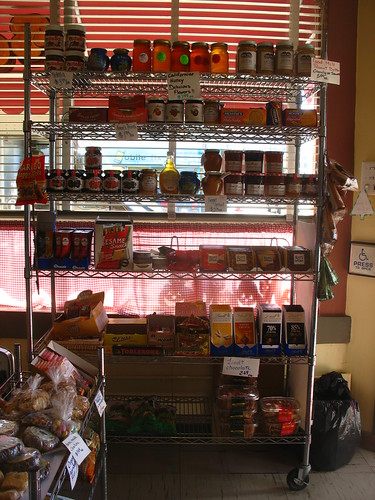
I haven't tried the Home Maid pasta yet.
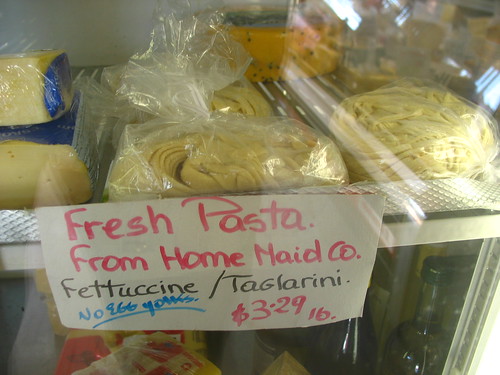
But I've sampled a lot of the chocolate. Today I had this one...
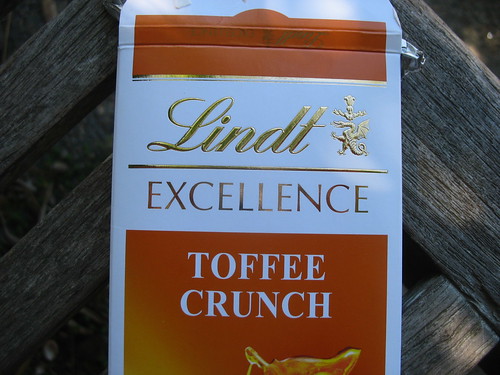
after I ate my sandwich...

while sitting on a quiet bench in the San Francisco Botanical Garden.
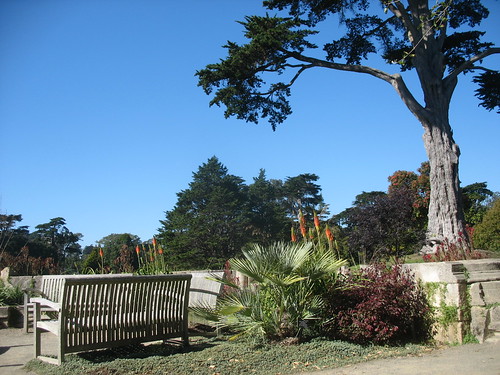
I come here for lunch and get a sandwich once or twice a week. It's close enough to my office to walk to, and far enough to give me a little exercise and clear my mind.

They sell mostly imported European cheeses, but there are some Californian goat cheeses too.

I like cheese, but I'm not a connoisseur. English Cotswold is my favorite.

They sell other things. All the olives are imported.

And they make sandwiches. I usually geta ham and cheese.
On days when the husband's there, I say "Can I have a ham and cheese sandwich?" and he makes it for me. When the wife is there, I say "Can I have a ham and cheese sandwich?" and she comes back with, "What kind of ham? What kind of cheese? What kind of bread? Do you want everything? Onions?"
Most peoople (most Americans?) probably prefer the wife's approach, and that's fine. I get that. But I actually prefer the husband's approach. If I wanted to micromanage every detail of my sandwich, I would say so when I placed my order. It's just a sandwich.
There--that's a little something about me you might not have known.
I don't usually get a drink, but these look good.

And so do these.



I haven't tried the Home Maid pasta yet.

But I've sampled a lot of the chocolate. Today I had this one...

after I ate my sandwich...

while sitting on a quiet bench in the San Francisco Botanical Garden.

10/20/08
Point Reyes Community Garden (west Marin County, part 2)
10/19/08
U-pick chestnuts on the peninsula
I can't say that I love to eat roasted chestnuts, but walking through a chestnut grove sounds like a nice way to pass a couple of hours on an autumn afternoon.
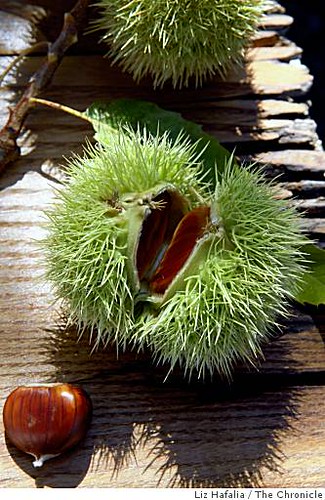
"The mighty American chestnut tree once was an integral part of Eastern forests, but it has been virtually wiped out by a fungus. Luckily for people in the Bay Area who'd like to enjoy chestnuts, though, a few small groves of other varieties survive locally."Link.

10/18/08
An October Visit to West Marin, Part 1
We went for a nice drive in west Marin County today.
Here we are heading through town on the way out.
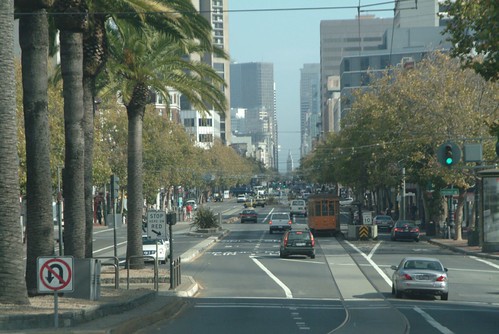
And here we are getting out.


Mostly Natives Nursery, one of my favorites, is in the town of Tomales. We visited the nursery before and you may have seen Tomales in the movies:
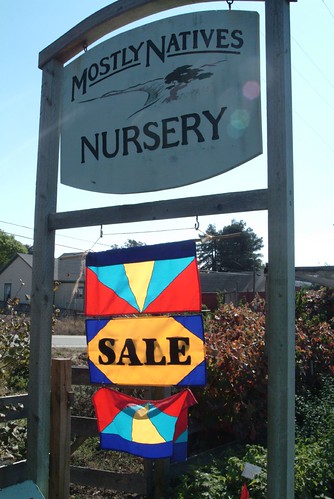
They were having a big fall sale, and I wish I'd spent more money.
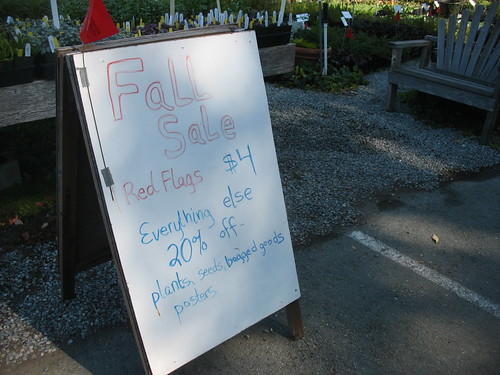
More money on grasses...
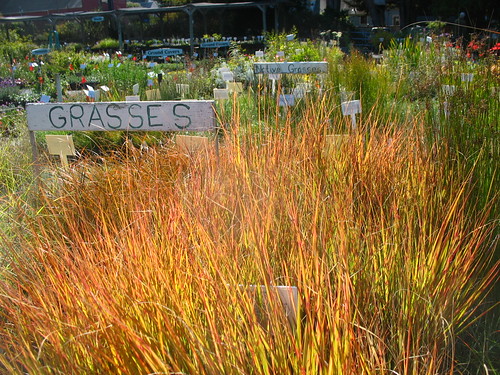

And a Dawn Redwood.
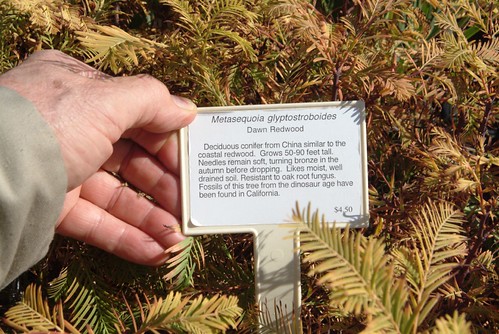
Metasequoia can grow in pots for years.
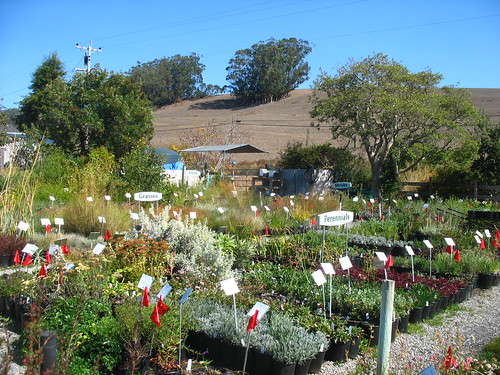

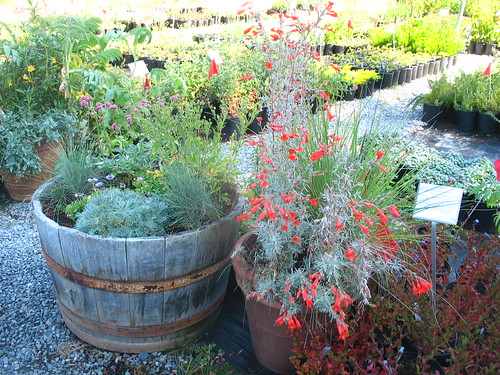

Tomales is a tiny town...

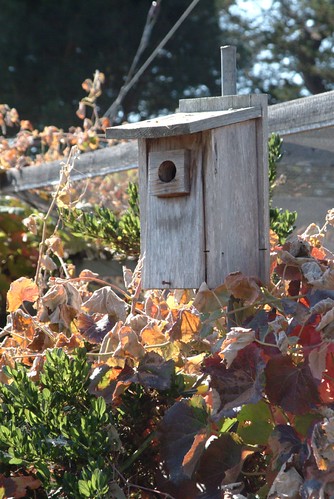
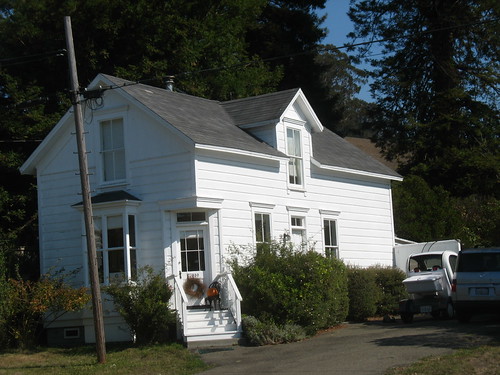
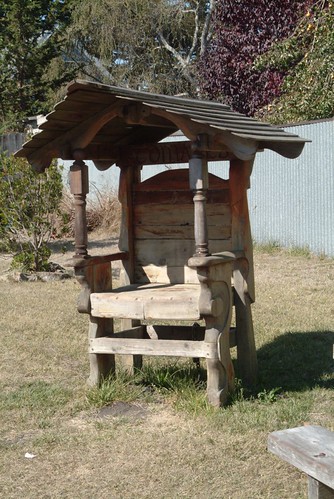
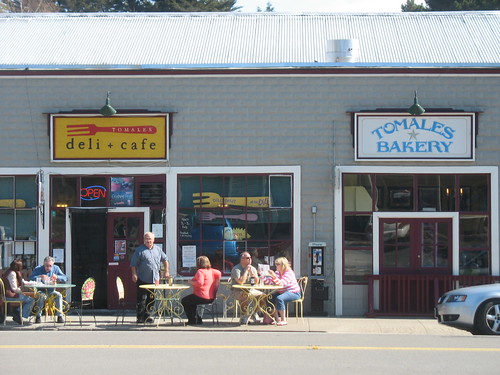
near lovely Tomales Bay

where you can paddle or sail
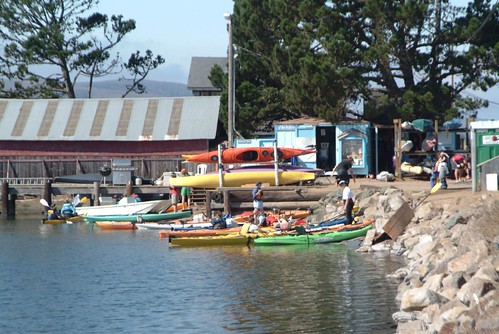
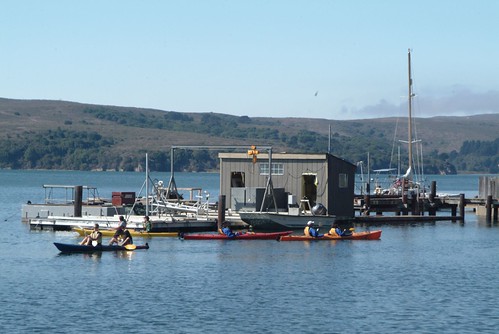

and have oysters and beer.
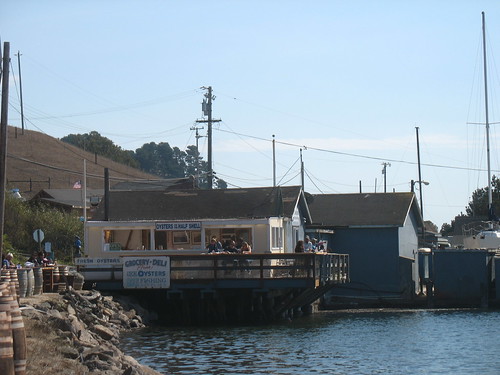
Here we are heading through town on the way out.

And here we are getting out.


Mostly Natives Nursery, one of my favorites, is in the town of Tomales. We visited the nursery before and you may have seen Tomales in the movies:
"Much of the 2001 movie Bandits was filmed in and around Tomales, as were the opening shots of Mumford (1999), and parts of Scream (1996), and Village of the Damned (1995)."Well, I saw Scream.

They were having a big fall sale, and I wish I'd spent more money.

More money on grasses...


And a Dawn Redwood.

Metasequoia can grow in pots for years.




Tomales is a tiny town...





near lovely Tomales Bay

where you can paddle or sail



and have oysters and beer.

Subscribe to:
Comments (Atom)
